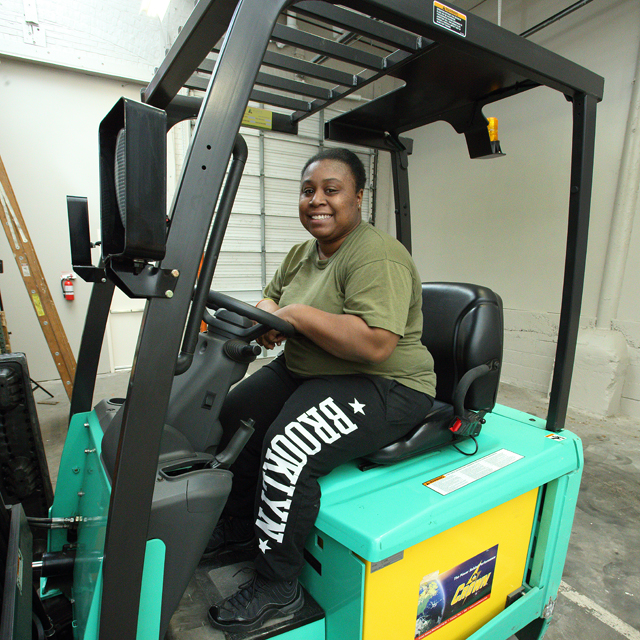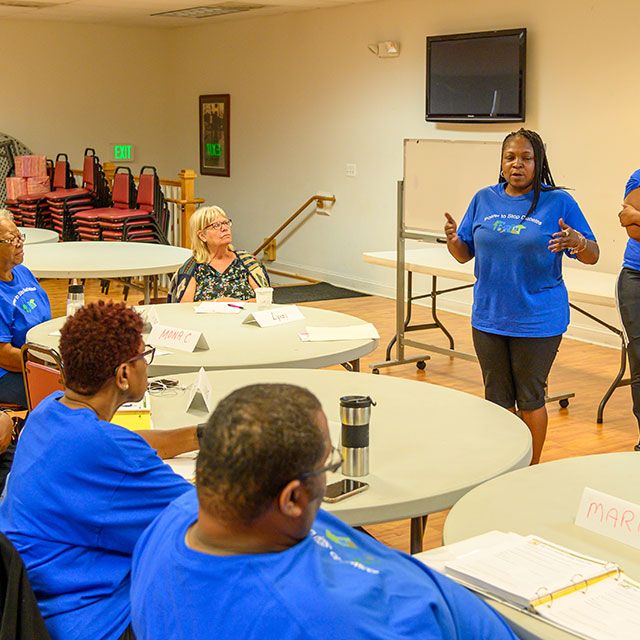On the wobbly coffee table, a stack of bills sits next to a plastic freezer bag filled with inhalers, pill bottles and other medicines. Diabetes, asthma and a tendency to develop dangerous blood clots deep in her legs are among the health problems facing 47-year-old Roslyn Jordan every day. Her illnesses have also led to joblessness, financial hardship and an electric bill that is months overdue.
When she tells a visitor that the disability stipend from Social Security fails to cover her monthly expenses, William Glover-Bey reassures her. The Johns Hopkins community health worker has traveled to Jordan’s tiny Northeast Baltimore apartment today to help her find a way to keep the lights on.
Community health workers are well versed in finding resources for people who need them. Glover-Bey has researched Jordan’s case and knows that, because she uses an electric wheelchair that requires daily recharging, the gas and electric company will not shut off her power — as long as she fills out the proper paperwork. He and Jordan review the details of the program and go over the forms she needs to sign.
“That’s been such a worry for me,” Jordan says.
Glover-Bey, 62, has overcome difficulties as well — the Baltimore native spent time in prison for drug-related felony convictions. After years of problems finding work due to his criminal record, Glover-Bey learned about a Johns Hopkins Health System effort to hire people returning from incarceration. In 2015, he took a job in the hospital’s environmental services department and, after training, found his current position.
“I love what I do,” he says. “A lot of people in our city need a lot of help. I feel so fortunate to be able to help them out a little bit and maybe make them smile.”
Community health workers, usually trusted members of the communities they serve, have helped American hospitals and other health care institutions tackle public health problems since the 1970s. They connect patients and families with health care and support services that address social factors of poverty — such as lack of access to nutritious food — that contribute to poor health.
Expansion of such programs during the last decade is linked to the federal Affordable Care Act (ACA) enacted in 2010. The ACA mandated that the Centers for Medicare and Medicaid Services (CMS) begin cutting back on hospital reimbursement for care provided to patients readmitted within 30 days of discharge.
When a patient is hospitalized for a heart attack, for example, the patient’s private insurer or a public payer, such as Medicare, reimburses the hospital. But if, within a month, the patient requires readmission to the hospital for a complication stemming from the heart attack, some or all of the hospital’s reimbursement claims could be denied.
Scott Berkowitz, associate professor of medicine and senior medical director for accountable care for the Office of Johns Hopkins Physicians, says working to reduce readmissions through improved care coordination and support systems is good for patients as well as the American health care system.
“It’s our job to partner with patients and families to get the care right and to create the post-discharge plan,” Berkowitz says.
Better, Less Expensive Care
Beginning in 2013, Berkowitz led the Johns Hopkins Community Health Partnership (J-CHiP), a four-year, $20 million study aimed at reducing barriers to care for underserved people in East Baltimore, as well as reducing hospital readmissions overall. The study, funded by a Health Care Innovation Award from CMS, relied heavily on community health workers as part of ambulatory health care teams customized to address each individual patient’s condition and barriers to care.
In 2018, the study’s results, published in the Journal of the American Medical Association Network Open, reported that the program not only helped East Baltimore residents become healthier, but also saved Medicare and Medicaid a total of $113 million.
“We set out to assemble a care coordination model that could keep people healthy and out of the hospital, and to keep those already hospitalized from being readmitted,” says Berkowitz, the lead author of the publication and a member of the program’s leadership team.
Now, several years after the J-CHiP study, community health workers remain an important part of care at Johns Hopkins.
As a community health worker at the Johns Hopkins Sickle Cell Center for Adults, Sheree Gatewood is responsible for a roster of 40 or so underserved patients, each of whom faces different barriers to managing their disease effectively.
Sickle cell disease is an inherited disorder that primarily affects people of African ancestry. A genetic defect distorts red blood cells so that they become crescent shaped, rather than round. In addition to increasing the risk of stroke, heart disease and other life-threatening conditions, the irregular cells can’t transport as much oxygen, and they can cause severe pain.
Economic, physical, emotional and other barriers can make it difficult for patients to manage their disease. Gatewood calls her patients frequently to remind them of doctor appointments, to arrange transportation for those with mobility problems and to help them get medicine.
On her way to meet a new client at the Sickle Cell Center in the Johns Hopkins Outpatient Center, the community health worker spots a familiar face in a group of patients waiting for an intravenous infusion of oxygen-rich red blood cells.
She pauses for a quick visit. “How you feelin’, baby?” she asks the middle-aged woman, whose aluminum cane leans against her chair. The woman’s swollen right ankle bulges above her shoe and a bulky bandage covers a leg ulcer that has been slow to heal.
“I’m OK. I’ve had a few bad days this week, but I’m hangin’ in there,” she says, smiling through obvious pain.
Then the woman tells Gatewood about the new motorized wheelchair that’s on order for her.
“Ooh, that’s going to be nice,” the health worker responds. “I can’t wait for you to give me a ride!”
The two women share a laugh as Gatewood leans over and gently embraces the patient. “You take care, now,” she urges. “And you know to call me if you need anything.”
“I know,” the woman replies softly. “Thank you, Sheree.”
Gatewood notices a greasy fast-food bag full of breakfast sandwiches and fried potatoes.
“I do wish you’d eat a little healthier.”
“I know, I know,” the woman replies.
Gatewood gives her hand a little squeeze.
Walking away, Gatewood explains that many of her patients rely on cheap, salty, calorie-packed food for sustenance.
“When you’re not sure how you’ll afford food and shelter for yourself and your family, it’s not easy to stay on top of [managing] a disease like sickle cell,” she says. “You’ll eat bad food, you’ll miss doctors’ appointments, you won’t fill prescriptions and, before long, you’re in a crisis.”
It’s Gatewood’s business to know which nonprofit agencies can help pay the rent, which food banks are the most reliable, and how to get MTA vouchers and other vital resources that Baltimore’s poorest residents depend on.
Her newest patient waits in a Sickle Cell Center exam room, where she has just met with her physician. The patient is a woman in her 20s who just moved to Baltimore for a job that will help her pay for nursing school.
Carrying a manila envelope full of information about the Sickle Cell Center, Gatewood knocks on the exam room door, pokes her head in and greets the woman warmly.
“Good morning! My name is Sheree,” she says. “Welcome to the family!”




